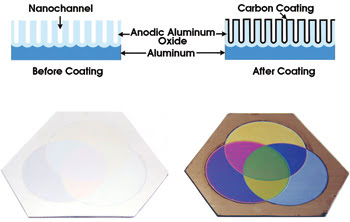
Thin, Colorful Carbon Films
Hank Hogan
A research group comprising members from Tohoku University in Sendai, Japan, and from Peking University has found that when a thin anodic aluminum oxide (AAO) film on an aluminum substrate is coated uniformly with carbon, the result is an enhancement of the interference color saturation. Thus, the coated film exhibits a brilliant color that is tunable by varying the film thickness.

An anodic aluminum oxide film with nanoscale channels at the surface sits on top of an aluminum substrate (top left). The film is coated with a thin layer of carbon, resulting in bulk carbon and carbon nanotubes in the channels (top right). On the bottom left is an image of films of various thicknesses before carbon coating; on the bottom right is an image of the same film thicknesses after carbon coating. Reprinted with permission of the American Institute of Physics.
The researchers often used thick AAO films to prepare long carbon nanotubes, and such films are black. Sometimes, however, they used thin films and, on one occasion, they noticed something strange, said Xiao-Hui Wang, a postdoctoral researcher at Tohoku University. “When the sample using such a thin anodic aluminum oxide film was taken out of a chemical vapor deposition chamber, the resulting carbon-coated AAO film appeared brilliantly colorful.”
Wang noted that it is well-known that uncoated AAO films show a visible interference color — a result of light reflected off the substrate and then partially reflected off the film-air interface. However, no one, to the best of the group’s knowledge, had previously used carbon to enhance the color.
While investigating the mechanism behind the effect, the researchers created AAO films by oxidizing aluminum in an aqueous acid for periods from 27 s to 10 min, resulting in films ranging from hundreds of nanometers to more than 1 μm thick. During their growth, these films formed inner channels that were about 30 nm.
After cleaning the AAO film, they coated it with a uniform 5-nm-thick layer of carbon nanotubes embedded in the nanoscale channels and with a standard carbon layer on the external surface.
Applications
They measured the reflectance spectra of both coated and uncoated films using a UV-VIS spectrophotometer from Jasco Corp. of Tokyo. They found that the carbon-coated films had a strong spectral dependence on the film thickness, had enhanced color saturation and exhibited shrinking interference patterns with decreasing wavelength. By carefully removing the carbon and taking reflectance spectra measurements as they did so, the researchers established that the carbon nanotubes were responsible for the color changes because of their refractive index and consequent effect on interference.
Wang noted that the growth of the films and their later carbon coating were both technically straightforward and easy to control, which could make eventual application of the discovery easier. The technique could be used to produce decorative films; if used on a transparent substrate such as glass, it holds promise as a broadband optical limiter for nanosecond laser pulses as well.
“The light intensity could be adjusted by changing the carbon-coated AAO with different thicknesses or by slightly rotating the substrate to change the optical paths,” Wang said.
Another possible application under investigation involves solar water heating. The carbon-coated film would be used as an absorbing medium.
Applied Physics Letters, July 2, 2007, Vol. 91, 011908.
Published: September 2007